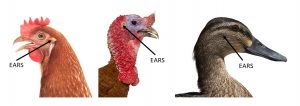Written by: Dr. Jacquie Jacob, University of Kentucky
Most birds, including chickens, hear well. Birds have ears on both sides of their heads, and unlike humans, birds do not have external flaps on their ears. Instead, the opening of the ear is covered by a special tuft of feathers. These feathers protect the ear without impairing perception of sound. Waterfowl can close the openings of their ears before diving.

Chicken embryos generally begin hearing on day 12 of incubation. For the first few days after hatching, chicks tend to eat very little as they explore an area and learn what is safe to eat and what is not. When chicks are raised with a mothering hen, the hen helps the chicks identify foods by making specific sounds known as auditory clues. If chicks are raised without a hen, tapping sounds increase feeding behavior, presumably because such sounds imitate the pecking noise of a mother hen.
Similarly, when researchers played hen vocalizations over speakers placed near feed, chicks exposed to the recordings had heavier body weights than flock mates that were not exposed to the recordings. Performance differences were no longer detected after the sounds were discontinued (at nine days after hatching). The chicks were presumably attracted to the vocalizations of the hen and spent more time near the speakers, where the food was.
Like mammals, birds have an outer ear, a middle ear, and an inner ear. The outer ear collects sound waves and channels them into the middle ear. The middle ear is separated from the outer ear by a membrane often referred to as the eardrum. The sound waves make the eardrum vibrate. These vibrations are then picked up by the middle ear and transferred to the inner ear. Instead of the three bones of the mammalian middle ear, the avian middle ear has a single structure of bone and cartilage known as the columella. It is the columella that transfers the vibrations to the inner ear. The inner ear is responsible for the initial analysis of the vibrations. The columella transmits the vibrations to the cochlea in the inner ear, where special nerve endings receive it and transmit the information to the auditory nerve. The auditory nerve sends the information to the part of the brain that recognizes the information as sound.
The inner ear is also important in maintaining balance, a function that is particularly important for birds that fly. In addition, special ducts connect the middle ear with the roof of the mouth, regulating air pressure in the middle ear to prevent injury to the eardrum.
Human hearing loss associated with age is typically the result of damage to the sensory hair cells in the inner ear. Humans are not able to regrow damaged hair cells. In contrast, chickens are able to regrow these hair cells, and as a result, chickens are being studied for insights into treating hearing loss in humans.
Birds are able to perceive sounds more quickly than can humans. They are able to pinpoint the source of a sound by assessing the lag time between the sound’s arrival at either side of the head. Due to this lag time, it is easier for birds to locate the source of a series of brief sounds than of a single continuous sound.
In a study examining the effects of noise from low-flying military aircraft on wild waterfowl, researchers measured noise levels at various distances from spring staging, breeding, and molting flocks. Researchers then monitored the birds’ behavior and found that the behavior did not vary with the distance from the noise. They concluded that either the birds had become habituated to the noise, or for some reason the noise did not appear to affect them.
The efficacy of spray-on biologicals, such as coccidiosis vaccine, depends on birds consuming the product, a process that typically takes place during preening. Preening activity of chicks decreases with increasing noise levels, so it is recommended that noise levels be kept low, if possible, during the application of biologicals.
While many producers provide laying hens with music, there is some recent research (2005) that indicates that playing classical musice in the laying house can have a negative ilnfluence on the level of fearfulness. Some of the reaction to the music was related to the playing of cassette tapes. Addition research is needed to investigate the effects of different types of music, different intensities, and the use of CDs rather than cassettes.

